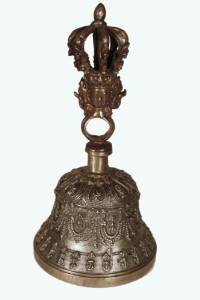Back to the main page Back to category Tibetan
musical instrument details
Antique Bell / Tibetan Meditation Bell / Tibetan / Multi-Layered Harmonics / Meditation Tool
Estimated price for orientation: 2 436 $
Category: Tibetan
Class:
Features Antique & Collectible Pre -1940 Age Unknown 7.25 x 3.5 x 3.5 Inch Buddhist Altar Bell to Benefit All Sentient Beings Native Tibetan Gallery Quality Master Healing Chakra Balancing Quality Bell / No Screw Into Stem Display Buddhist Altar/Home or Office to Support Free Tibet & Nepal Dakini Blessed Reiki Tummo Infused by Reiki Master Description Product Description Traditional craft passed down the centuries, precious materials cast into a magical spell. Native crafts help support Tibetan refugees. Reiki Tummo energy blessing added for health & happiness. The sound created by the tingsha is a plea to the gods....whom the drums have called down to earth...to remain here. Tibetan Lama ritual bell from Monastery. Lovely sound for meditation practice. Unique decorative Buddhist bell. In Tantric Buddhism the dorje & bell are used in many rites by lamas. The dorje is a male polysemic symbol that represents many things for the tantrika. The dorje is representative of upaya (Sanskrit) whereas its companion tool, the bell which is a female symbol, denotes prajna (Sanskrit). Some deities are shown holding each part of the vajra in separate hands, this symbolizes the union of the forces of compassion and wisdom. A bell can be 8, 12, 16, 18 or 22 finger-widths in height. Its base must be round, above which is a vase surmounted by the face of the goddess Prajnaparamita. Above these are a lotus, a moon disc & finally a vajra.The hollow of the bell symbolizes the wisdom cognizing emptiness. The clapper represents the sound of emptiness. The 8 lotus petals are the 4 mothers & 4 goddesses & the vase represents the vase containing the nectar of accomplishment. Paired with the vajra, the bell represents wisdom, & as wisdom & method are an undivided unity so the vajra & bell are never parted or employed separately. In Tibetan oral tradition, the bell dates back to the time of the historical Buddha. The tradition was brought from India to Tibet, along with the teachings of the Buddha, by the great tantric master Padmasambhava in the 8th century. Bells produce sounds which invoke a deep state of relaxation which naturally assists one in entering into meditation, the ultimate goal being enlightenment. They are an aid to meditation, & can be found on private Buddhist altars, & in temples, monasteries & meditation halls throughout the world.
Features Antique & Collectible Pre -1940 Age Unknown 7.25 x 3.5 x 3.5 Inch Buddhist Altar Bell to Benefit All Sentient Beings Native Tibetan Gallery Quality Master Healing Chakra Balancing Quality Bell / No Screw Into Stem Display Buddhist Altar/Home or Office to Support Free Tibet & Nepal Dakini Blessed Reiki Tummo Infused by Reiki Master Description Product Description Traditional craft passed down the centuries, precious materials cast into a magical spell. Native crafts help support Tibetan refugees. Reiki Tummo energy blessing added for health & happiness. The sound created by the tingsha is a plea to the gods....whom the drums have called down to earth...to remain here. Tibetan Lama ritual bell from Monastery. Lovely sound for meditation practice. Unique decorative Buddhist bell. In Tantric Buddhism the dorje & bell are used in many rites by lamas. The dorje is a male polysemic symbol that represents many things for the tantrika. The dorje is representative of upaya (Sanskrit) whereas its companion tool, the bell which is a female symbol, denotes prajna (Sanskrit). Some deities are shown holding each part of the vajra in separate hands, this symbolizes the union of the forces of compassion and wisdom. A bell can be 8, 12, 16, 18 or 22 finger-widths in height. Its base must be round, above which is a vase surmounted by the face of the goddess Prajnaparamita. Above these are a lotus, a moon disc & finally a vajra.The hollow of the bell symbolizes the wisdom cognizing emptiness. The clapper represents the sound of emptiness. The 8 lotus petals are the 4 mothers & 4 goddesses & the vase represents the vase containing the nectar of accomplishment. Paired with the vajra, the bell represents wisdom, & as wisdom & method are an undivided unity so the vajra & bell are never parted or employed separately. In Tibetan oral tradition, the bell dates back to the time of the historical Buddha. The tradition was brought from India to Tibet, along with the teachings of the Buddha, by the great tantric master Padmasambhava in the 8th century. Bells produce sounds which invoke a deep state of relaxation which naturally assists one in entering into meditation, the ultimate goal being enlightenment. They are an aid to meditation, & can be found on private Buddhist altars, & in temples, monasteries & meditation halls throughout the world.
